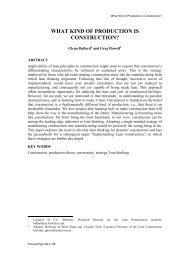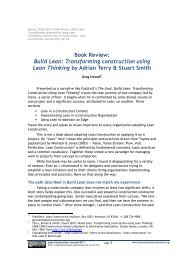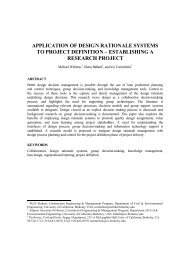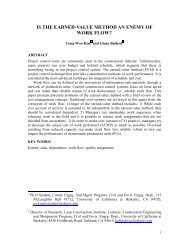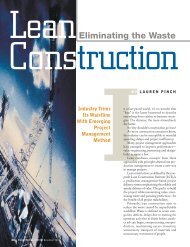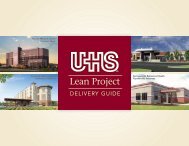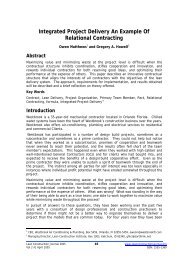just-in-time concrete delivery - Lean Construction
just-in-time concrete delivery - Lean Construction
just-in-time concrete delivery - Lean Construction
Create successful ePaper yourself
Turn your PDF publications into a flip-book with our unique Google optimized e-Paper software.
Just-<strong>in</strong>-Time Concrete Delivery: Mapp<strong>in</strong>g Alternatives for Vertical Supply Cha<strong>in</strong> Integration<br />
JUST-IN-TIME CONCRETE DELIVERY:<br />
MAPPING ALTERNATIVES<br />
FOR VERTICAL SUPPLY CHAIN INTEGRATION<br />
Iris D. Tommele<strong>in</strong> 1 and Annie En Yi Li 2<br />
ABSTRACT<br />
This paper expla<strong>in</strong>s concepts underly<strong>in</strong>g a <strong>just</strong>-<strong>in</strong>-<strong>time</strong> production system. Just-<strong>in</strong>-<strong>time</strong><br />
production systems as implemented by Toyota are pull systems <strong>in</strong> which ‘kanban’ convey the<br />
need to replenish the right <strong>in</strong>ventory at the right <strong>time</strong> and <strong>in</strong> the right amount. In this paper,<br />
symbols from manufactur<strong>in</strong>g are <strong>in</strong>troduced to map resource flows <strong>in</strong> order to help<br />
dist<strong>in</strong>guish traditional- from lean production processes. These symbols are then applied to<br />
construction. Ready-mix <strong>concrete</strong> provides a prototypical example of a <strong>just</strong>-<strong>in</strong>-<strong>time</strong><br />
construction process. Ready-mix <strong>concrete</strong> is a perishable commodity, batched to<br />
specifications upon customer demand. This makes <strong>just</strong>-<strong>in</strong>-<strong>time</strong> <strong>delivery</strong> necessary. Based on<br />
data from <strong>in</strong>dustry case studies, alternative forms of vertical supply cha<strong>in</strong> <strong>in</strong>tegration were<br />
<strong>in</strong>vestigated. The most common one is where the batch plant also delivers the mix to the<br />
contractor’s project site. An alternative is for the contractor to haul the mix from the batch<br />
plant to the project site with their own revolv<strong>in</strong>g-drum trucks. One alternative is favored over<br />
the other depend<strong>in</strong>g on the amount of control the contractor wants <strong>in</strong> terms of on-<strong>time</strong> site<br />
<strong>delivery</strong> of <strong>concrete</strong> and the variability <strong>in</strong> the contractor’s demand for <strong>concrete</strong> project after<br />
project. Insights can be ga<strong>in</strong>ed from these two examples on how the construction <strong>in</strong>dustry has<br />
adopted a <strong>just</strong>-<strong>in</strong>-<strong>time</strong> production system for at least one part of the <strong>concrete</strong> supply cha<strong>in</strong>.<br />
The examples provided will help the reader th<strong>in</strong>k through issues perta<strong>in</strong><strong>in</strong>g to the need for<br />
hav<strong>in</strong>g <strong>in</strong>formation, materials, and <strong>time</strong> buffers at strategic locations <strong>in</strong> construction<br />
processes.<br />
KEY WORDS<br />
Supply-cha<strong>in</strong> mapp<strong>in</strong>g, vertical supply-cha<strong>in</strong> <strong>in</strong>tegration, ready-mix <strong>concrete</strong>, pull-driven<br />
schedul<strong>in</strong>g, <strong>just</strong> <strong>in</strong> <strong>time</strong>, JIT, kanban, lean construction.<br />
1<br />
2<br />
Associate Professor, Constr. Engr. and Mgmt. Program, Civil and Envir. Engrg.<br />
Department, 215-A McLaughl<strong>in</strong> Hall, Univ. of California, Berkeley, CA 94720-1712,<br />
510/643-8678, FAX 510/643-8919, tommele<strong>in</strong>@ce.berkeley.edu<br />
Senior (B.S. Degree), Constr. Engr. and Mgmt. Program, Civil and Envir. Engrg.<br />
Department, 215-A McLaughl<strong>in</strong> Hall, Univ. of Calif., Berkeley, CA 94720-1712,<br />
510/536-1782, annieli@ucl<strong>in</strong>k4.berkeley.edu<br />
Proceed<strong>in</strong>gs IGLC-7 97
Tommele<strong>in</strong> and Li<br />
INTRODUCTION<br />
The term ‘Just-In-Time’ (JIT), used for <strong>in</strong>stance to describe the <strong>delivery</strong> of materials to a<br />
construction site, suggests that materials will be brought to their location for f<strong>in</strong>al <strong>in</strong>stallation<br />
and be <strong>in</strong>stalled immediately upon arrival without <strong>in</strong>curr<strong>in</strong>g any delay due to storage <strong>in</strong> a<br />
laydown or stag<strong>in</strong>g area. JIT is a concept developed by the Japanese who created the Toyota<br />
Production System, later translated <strong>in</strong>to English as the lean production system. The ultimate<br />
objective of JIT production is to supply the right materials at the right <strong>time</strong> and <strong>in</strong> the right<br />
amount at every step <strong>in</strong> the process.<br />
Toyota achieves JIT production by implement<strong>in</strong>g a pull system us<strong>in</strong>g ‘kanban,’ loosely<br />
translated from Japanese as ‘cards.’ Kanban are designed to prevent overproduction and<br />
ensure that parts are drawn from process to process, <strong>in</strong> reverse order. They thus implement a<br />
replenishment system designed to control production quantities. Parts are taken and<br />
replenished only when needed and <strong>in</strong> the right amount.<br />
Instead of us<strong>in</strong>g special-purpose kanban, one can take advantage of reusable packag<strong>in</strong>g<br />
means (such as conta<strong>in</strong>ers, racks, or pallets) that are color coded and sized to designate a<br />
specific material. Leav<strong>in</strong>g the empty packag<strong>in</strong>g for the supplier to pick up from an agreedupon<br />
location then implies a request to replenish with product of the same quantity and type 3 .<br />
This system obviates the need for any oral or written communication.<br />
The pull of product from upstream is illustrated by means of a withdrawal kanban as<br />
shown <strong>in</strong> Figure 1. The customer process withdraws parts from a supermarket, which is a<br />
place of limited capacity for stor<strong>in</strong>g product that is output by the supply<strong>in</strong>g process. The<br />
supermarket gets replenished by issu<strong>in</strong>g a production kanban when <strong>in</strong>ventory is too low.<br />
The production kanban thereby <strong>in</strong>structs the supply<strong>in</strong>g process to produce more product. The<br />
supply<strong>in</strong>g process produces only enough product to replace what was withdrawn. This<br />
method prevents overproduction but allows a tightly-bound <strong>in</strong>ventory to build up between the<br />
supply<strong>in</strong>g and the customer process (for more detail, see Hopp and Spearman 1996 and<br />
Rother and Shook 1998).<br />
production<br />
KANBAN<br />
withdrawal<br />
KANBAN<br />
SUPPLYING<br />
PROCESS<br />
product<br />
product<br />
CUSTOMER<br />
PROCESS<br />
supermarket<br />
Figure 1: Kanban System (after Rother and Shook 1998 p. 42)<br />
3<br />
An example of a pull system like this one used to be the daily milk run! Kanban has<br />
jok<strong>in</strong>gly been referred to as ‘milk-run logistics.’<br />
98 26-28 July 1999, University of California, Berkeley, CA, USA
Just-<strong>in</strong>-Time Concrete Delivery: Mapp<strong>in</strong>g Alternatives for Vertical Supply Cha<strong>in</strong> Integration<br />
In a more general sense, a pull system may comprise a feedback mechanism for a station<br />
downstream to notify a station upstream that more product is needed. Product then is<br />
fabricated and shipped to meet this specific need. The alternative is to produce product <strong>in</strong><br />
anticipation of a need, i.e., based on a forecast need, as is the case <strong>in</strong> push systems.<br />
Tommele<strong>in</strong> (1997, 1998) compared and contrasted the <strong>delivery</strong> and <strong>in</strong>stallation of pipe spool<br />
at a construction site subject to various uncerta<strong>in</strong>ties us<strong>in</strong>g pull- and push-driven schedul<strong>in</strong>g<br />
methods. Push systems tend to <strong>in</strong>crease the amount of waste (e.g., long wait <strong>time</strong>s,<br />
excessively large <strong>in</strong>ventories) because they are estimate driven and <strong>in</strong>clude fudge factors to<br />
compensate for anticipated uncerta<strong>in</strong>ty. Uncerta<strong>in</strong>ty may or may not manifest itself dur<strong>in</strong>g<br />
project execution. When it does, push systems have no means to adapt to chang<strong>in</strong>g system<br />
requirements whereas pull systems do.<br />
In this paper, the batch<strong>in</strong>g and <strong>delivery</strong> of ready-mix <strong>concrete</strong> are used to illustrate a pull<br />
system. Ready-mix <strong>concrete</strong> is a prototypical example of a batch process, where a customer<br />
process (the contractor) releases an order to batch to the supply<strong>in</strong>g process (the batch plant)<br />
and receives product as a result (Figure 2). This batch process does not allow any <strong>in</strong>ventory<br />
of product to be ma<strong>in</strong>ta<strong>in</strong>ed because the product is perishable.<br />
batch<br />
SUPPLYING<br />
PROCESS<br />
product<br />
CUSTOMER<br />
PROCESS<br />
Figure 2: Concrete Batch<strong>in</strong>g Process<br />
To <strong>in</strong>vestigate <strong>in</strong>dustry practice <strong>in</strong> more detail, we collected data describ<strong>in</strong>g the operation of<br />
a ready mix plant. Ready mix plants serve their customers not only by mix<strong>in</strong>g but also by<br />
transport<strong>in</strong>g <strong>concrete</strong> and deliver<strong>in</strong>g it to the location for placement on site. We illustrate this<br />
example by us<strong>in</strong>g value stream mapp<strong>in</strong>g symbols that have been used for some <strong>time</strong> to<br />
describe alternative states of manufactur<strong>in</strong>g facilities and to identify opportunities for mak<strong>in</strong>g<br />
their processes leaner (Rother and Shook 1998). For comparison, we also <strong>in</strong>terviewed a<br />
contractor specialized <strong>in</strong> plac<strong>in</strong>g <strong>concrete</strong> for road repair who acquired his own revolv<strong>in</strong>gdrum<br />
trucks to transport <strong>concrete</strong> to his projects. These two examples illustrate alternative<br />
forms of vertical supply cha<strong>in</strong> <strong>in</strong>tegration. They differ <strong>in</strong> who owns and therefore controls the<br />
schedul<strong>in</strong>g of ready mix trucks. One alternative is favored over the other depend<strong>in</strong>g on the<br />
amount of control the contractor wants <strong>in</strong> terms of on-<strong>time</strong> site <strong>delivery</strong> of <strong>concrete</strong> and the<br />
variability <strong>in</strong> the contractor’s demand for <strong>concrete</strong> project after project.<br />
READY-MIX CONCRETE<br />
Concrete is a very common construction material. Projects rang<strong>in</strong>g from a s<strong>in</strong>gle family<br />
home to a high-rise build<strong>in</strong>g all may need <strong>concrete</strong> for their foundation, slabs, columns,<br />
beams, walls, etc. to be constructed. In urban sett<strong>in</strong>gs, the task of deliver<strong>in</strong>g <strong>concrete</strong> more<br />
Proceed<strong>in</strong>gs IGLC-7 99
Tommele<strong>in</strong> and Li<br />
often than not has been delegated to ready-mix batch plants and contractors have to rely on<br />
the tim<strong>in</strong>g and reliability of their service. Although this set-up puts the contractor’s project<br />
somewhat at the mercy of the batch plant, most batch plants perform at their very best to<br />
meet their customers’ schedules. On-<strong>time</strong> <strong>delivery</strong> is part of the product they sell.<br />
The <strong>in</strong>terplay between contractors and batch plants is <strong>in</strong>terest<strong>in</strong>g. On one hand, the<br />
contractor must order a large enough quantity, sufficiently long ahead of <strong>time</strong> to ensure<br />
available batch plant capacity and <strong>time</strong>ly <strong>delivery</strong> service <strong>in</strong> order to maximize productivity<br />
of their plac<strong>in</strong>g crew. On the other hand, the batch plant tries to <strong>time</strong> its deliveries so that all<br />
projects are served accord<strong>in</strong>g to the contractors’ needs and the plant as well as the trucks and<br />
drivers have little idle <strong>time</strong>. This balanc<strong>in</strong>g act between the two parties is not always<br />
achieved due to the nature of <strong>concrete</strong> and the nature of the production systems be<strong>in</strong>g used.<br />
In addition to contractors and batch plants, this balanc<strong>in</strong>g act also <strong>in</strong>volves the suppliers<br />
of raw materials to the batch plant, crews on site that erect formwork and tie re<strong>in</strong>forc<strong>in</strong>g bars<br />
<strong>in</strong> preparation for <strong>concrete</strong> placement, as well as others. Although the <strong>in</strong>terdependence of all<br />
these parties typically results <strong>in</strong> uncerta<strong>in</strong>ties rippl<strong>in</strong>g through the supply cha<strong>in</strong>, the focus of<br />
this paper is limited to the downstream-, namely the contractor vs. batch plant relationship.<br />
NATURE OF CONCRETE<br />
Although batch<strong>in</strong>g and deliver<strong>in</strong>g <strong>concrete</strong> are common tasks, they are driven by many<br />
material-specific considerations.<br />
• Concrete is a Perishable Material: Concrete consists of coarse aggregates, f<strong>in</strong>e<br />
aggregates, cement, and water, plus admixtures if specified. Aggregates, cement, and<br />
admixtures separately can be stored for long periods of <strong>time</strong>. Concrete itself, though,<br />
is a perishable material. Once water has been added to the mix of dry materials,<br />
<strong>concrete</strong> only has a mere hour and a half or so (unless retarders are used) before the<br />
hydration process will form a gel that, if disrupted, would jeopardize the ultimate<br />
strength of the <strong>concrete</strong>. Hence, fresh <strong>concrete</strong> leaves little room for variability <strong>in</strong><br />
terms of <strong>time</strong> for <strong>delivery</strong> and placement after water has been added.<br />
• Concrete is a Custom Specified Material: Designers, usually civil/structural<br />
eng<strong>in</strong>eers, perform<strong>in</strong>g the structural calculations for a project determ<strong>in</strong>e the strength<br />
and other quality requirements for <strong>concrete</strong>. They may specify a <strong>concrete</strong> mix design<br />
or performance and then leave it up to the batch plant to propose a design that meets<br />
the specifications. Different mixes may be needed <strong>in</strong> different quantities on a s<strong>in</strong>gle<br />
project because of different uses for the <strong>concrete</strong> (e.g., shear wall vs. foundation slab)<br />
and a prim<strong>in</strong>g mix is needed prior to pump<strong>in</strong>g. Not all projects require a uniquely<br />
designed mix, however. Standard mixes are specified for <strong>in</strong>stance by government<br />
agencies for public works such as sidewalk and road pav<strong>in</strong>g. Accord<strong>in</strong>gly, most batch<br />
plants have an on-l<strong>in</strong>e database with recipes for hundreds if not thousands of mixes<br />
that they can load to program their facility. This makes it easy not only to add new<br />
mixes or f<strong>in</strong>d those that meet an eng<strong>in</strong>eer’s requirements, but also to name them<br />
based on customer preferences.<br />
• Availability of Ingredients: While f<strong>in</strong>d<strong>in</strong>g a suitable mix recipe may be easy, a batch<br />
plant may not stock all aggregate types or admixtures <strong>in</strong> quantity or at all (e.g., color<br />
100 26-28 July 1999, University of California, Berkeley, CA, USA
Just-<strong>in</strong>-Time Concrete Delivery: Mapp<strong>in</strong>g Alternatives for Vertical Supply Cha<strong>in</strong> Integration<br />
additives). When given the project specifications, the contractor must recognise when<br />
special <strong>in</strong>gredients are needed and notify the batch plant <strong>in</strong> a <strong>time</strong>ly manner so that it<br />
will have enough lead <strong>time</strong> to obta<strong>in</strong> them.<br />
CONCRETE PRODUCTION SYSTEM<br />
The production system for <strong>concrete</strong> is governed by the plant operator’s equipment, the<br />
contractor’s placement method, and of course, their <strong>in</strong>dividual schedules as well as the<br />
coord<strong>in</strong>ation of those schedules between them.<br />
• Batch Plants have Limited Capacity: A batch plant’s capacity is determ<strong>in</strong>ed by<br />
either batch<strong>in</strong>g capacity or <strong>delivery</strong> capacity.<br />
• Batch<strong>in</strong>g Capacity: is determ<strong>in</strong>ed by the <strong>time</strong> needed to measure, dispense, and mix<br />
<strong>in</strong>gredients, then load them <strong>in</strong>to a truck. The quantity mixed and thus the batch <strong>time</strong> is<br />
limited by the actual amount needed, the amount a truck can carry (typically 10 yd3),<br />
or weight limitations that may be imposed dur<strong>in</strong>g transportation or on site.<br />
Today’s ready-mix batch plants are fully automated and computer controlled so <strong>in</strong>gredients<br />
can be measured and mixed on demand and <strong>in</strong> virtually no <strong>time</strong>. This makes it possible to<br />
batch one truckload at a <strong>time</strong>, and load one truck after another with a different mix each <strong>time</strong><br />
when appropriate.<br />
• Delivery Capacity: is determ<strong>in</strong>ed by the number of trucks and drivers that service<br />
the batch plant. Typically, a batch plant may own 25 or 30 or so trucks and the plant<br />
operator will try to keep them busy at all <strong>time</strong>s. Batch plants may also load <strong>concrete</strong><br />
<strong>in</strong>to pickup- or revolv<strong>in</strong>g drum trucks owned by a third party.<br />
A plant’s batch<strong>in</strong>g capacity usually is larger than its <strong>delivery</strong> capacity. The batch <strong>time</strong> is on<br />
the order of a few m<strong>in</strong>utes. By contrast, the cycle <strong>time</strong> for a truck, <strong>in</strong>clud<strong>in</strong>g the load <strong>time</strong>,<br />
may be on the order of 30 m<strong>in</strong>utes up to an hour or two. A quick, determ<strong>in</strong>istic calculation<br />
based on a 2-m<strong>in</strong>ute load <strong>time</strong> and 30-m<strong>in</strong>ute truck cycle <strong>time</strong> yields 15 trucks possibly be<strong>in</strong>g<br />
served by the plant; a 1-hour cycle yields 30 trucks. Because of the significant variability <strong>in</strong><br />
cycle <strong>time</strong>, the batch plant will be idle at <strong>time</strong>s when wait<strong>in</strong>g for trucks to return, while<br />
trucks will experience ‘bunch<strong>in</strong>g’ at other <strong>time</strong>s when hav<strong>in</strong>g to l<strong>in</strong>e up at the plant.<br />
Trucks as well as the plant itself tie up a lot of capital; they are the fixed cost to the<br />
operator. Drivers’ and operators’ pay, truck operat<strong>in</strong>g costs, as well as materials make are the<br />
variable cost. A batch plant operator will thus vary the actual number of drivers work<strong>in</strong>g on<br />
any given day and vary their work hours to meet demand (e.g., for <strong>delivery</strong> at night or on a<br />
weekend day). Delivery thus tends to be the limit<strong>in</strong>g capacity factor.<br />
Other factors affect<strong>in</strong>g plant capacity are availability of materials and space to clean out<br />
trucks. However, <strong>in</strong> normal operat<strong>in</strong>g conditions, these will not govern.<br />
• Demand Fluctuation: Demand for <strong>concrete</strong> fluctuates throughout the day, week, and<br />
year. Even when the total amount of <strong>concrete</strong> for a specific placement or a project can<br />
be estimated reasonably well, the tim<strong>in</strong>g of the needed <strong>delivery</strong> often rema<strong>in</strong>s<br />
uncerta<strong>in</strong> because completion of prerequisite work at the site is difficult to forecast<br />
reliably and may not be known exactly up until a day or so prior to placement.<br />
Schedule uncerta<strong>in</strong>ty may perta<strong>in</strong> to work directly related to <strong>concrete</strong> placement, but<br />
also to work further upstream <strong>in</strong> the work sequence such as erect<strong>in</strong>g steel and plac<strong>in</strong>g<br />
Proceed<strong>in</strong>gs IGLC-7 101
Tommele<strong>in</strong> and Li<br />
deck<strong>in</strong>g on which then a rebar mesh is placed and a <strong>concrete</strong> slab cast. Plac<strong>in</strong>g<br />
<strong>concrete</strong> also is subject to unforeseen circumstances such as weather conditions. From<br />
the plant’s perspective, orders are called <strong>in</strong> randomly by contractors, so forecast<strong>in</strong>g<br />
the actual plant workload for any day is difficult to do.<br />
The ma<strong>in</strong> challenge for cost-effectively and reliably batch<strong>in</strong>g and plac<strong>in</strong>g <strong>concrete</strong> lies <strong>in</strong><br />
schedul<strong>in</strong>g. At the <strong>time</strong> a contractor calls <strong>in</strong> an order to a batch plant, many unknowns rema<strong>in</strong><br />
to be revealed. How a batch plant and the contractor handle these unknowns can be the<br />
determ<strong>in</strong><strong>in</strong>g factor for mak<strong>in</strong>g or los<strong>in</strong>g money.<br />
• Placement Size: Large placements require un<strong>in</strong>terrupted supply of <strong>concrete</strong> <strong>in</strong> order<br />
to avoid unplanned construction jo<strong>in</strong>ts. For <strong>in</strong>stance, jo<strong>in</strong>ts of any k<strong>in</strong>d would be<br />
unth<strong>in</strong>kable <strong>in</strong> large foundation mats requir<strong>in</strong>g several thousand cubic yards of<br />
<strong>concrete</strong>. A <strong>delivery</strong> sequence for un<strong>in</strong>terrupted supply at a site may require a loaded<br />
truck to always be on standby for <strong>concrete</strong> to be available when the preced<strong>in</strong>g truck<br />
has been emptied.<br />
To achieve the required cont<strong>in</strong>uity of <strong>delivery</strong>, plant and site must communicate<br />
<strong>in</strong> real <strong>time</strong> to relay when a placement is be<strong>in</strong>g delayed and to prevent that trucks<br />
would ‘bunch’ at the site. This communication is to a large extent implemented by<br />
means of a pull mechanism: each empty truck that returns to the plant is like a<br />
kanban, denot<strong>in</strong>g successful placement and therefore a request for additional<br />
batch<strong>in</strong>g. If a truck does not return to the plant <strong>in</strong> a <strong>time</strong>ly fashion, the plant will<br />
know it needs to hold off on mix<strong>in</strong>g more <strong>concrete</strong> for that placement. This pull<br />
mechanism may be mislead<strong>in</strong>g if a truck encounters road problems on the way back<br />
to the plant. To get more accurate, real-<strong>time</strong> data on truck travel and site conditions,<br />
state-of-the-art plants now use geographical <strong>in</strong>formation systems (GIS) based on local<br />
wireless telephone networks (rather than satellite-based systems).<br />
Large placements may tie up a considerable number of trucks and thus a plant’s<br />
capacity. A plant may even have to make arrangements with nearby plants to provide<br />
additional capacity or at least a backup <strong>in</strong> case problems with its production system<br />
were to arise.<br />
• Total Quantity Ordered of a Specific Mix: Raw materials for the batch plant<br />
(aggregates and cement) are typically restocked daily. Extra deliveries can be arranged<br />
if the need so dictates. Materials are loaded <strong>in</strong>to computer controlled b<strong>in</strong>s that<br />
feed scales, empty<strong>in</strong>g onto conveyor belts that lead to the mixer. Excess sands and<br />
gravels may be stored <strong>in</strong> open-air compartments, often located at the perimeter of the<br />
plant and moved with a loader to conveyors that get them <strong>in</strong>to the b<strong>in</strong>s when needed.<br />
It is conceivable for a plant to run out of materials though this rarely happens.<br />
When it does, it is seldom due to a poor replenishment system (most batch plants<br />
have close relationships with their upstream suppliers) but rather because of<br />
equipment failure.<br />
• Delivery Cycle and Location: S<strong>in</strong>ce <strong>concrete</strong> should be placed no later than n<strong>in</strong>ety<br />
m<strong>in</strong>utes after the addition of water, travel from the batch plant to a site should not<br />
take much more than half an hour or so. A plant’s operat<strong>in</strong>g radius therefore tends to<br />
be limited based on the nature and condition of haul roads.<br />
102 26-28 July 1999, University of California, Berkeley, CA, USA
Just-<strong>in</strong>-Time Concrete Delivery: Mapp<strong>in</strong>g Alternatives for Vertical Supply Cha<strong>in</strong> Integration<br />
Depend<strong>in</strong>g on the plant’s practices, drivers may r<strong>in</strong>se their vehicle after load<strong>in</strong>g<br />
but prior to leav<strong>in</strong>g the plant <strong>in</strong> order to avoid road spills of any k<strong>in</strong>d. The <strong>time</strong> a<br />
ready-mix truck may sit <strong>in</strong> traffic dur<strong>in</strong>g peak hours is a significant consideration<br />
when schedul<strong>in</strong>g site deliveries. Time must also be added to the truck cycle to<br />
account for f<strong>in</strong>d<strong>in</strong>g the site and ga<strong>in</strong><strong>in</strong>g access to the location for offload<strong>in</strong>g, as well<br />
as for test<strong>in</strong>g the mix before placement can start. Whenever possible, the plant<br />
operator will try to assign drivers that have been to a specific site to return to that site<br />
as their familiarity with gett<strong>in</strong>g there may slightly improve cycle <strong>time</strong>. A significant<br />
unknown is when a truck will be released by the contractor and able to depart from<br />
the project site. Upon return to the plant, a driver must wash out any remnants <strong>in</strong> the<br />
truck drum prior to tak<strong>in</strong>g on another mix. (Rout<strong>in</strong>e ma<strong>in</strong>tenance of trucks requires<br />
that hardened <strong>concrete</strong> be jack-hammered out of the drum every several weeks).<br />
To buffer aga<strong>in</strong>st schedule slippage dur<strong>in</strong>g the day, many batch plants have<br />
adopted a system with 2-hour <strong>time</strong> slots with only a limited number of orders be<strong>in</strong>g<br />
recorded per slot. They may guarantee on-<strong>time</strong> <strong>delivery</strong> only dur<strong>in</strong>g certa<strong>in</strong> <strong>time</strong>s of<br />
the day, e.g., <strong>in</strong> the early morn<strong>in</strong>g provided roads with traffic delays can be avoided.<br />
• Contractor Order<strong>in</strong>g and Tim<strong>in</strong>g of Delivery: As noted, the contractor must plan<br />
and prepare for the arrival of the <strong>concrete</strong>. When a contractor calls for a <strong>concrete</strong><br />
<strong>delivery</strong>, he needs to be ready to place that <strong>concrete</strong> once it arrives. However, same<br />
day orders for <strong>delivery</strong> at a specific <strong>time</strong> can seldom be guaranteed by a plant due to<br />
limited <strong>delivery</strong> capacity.<br />
On-<strong>time</strong> <strong>delivery</strong> of <strong>concrete</strong> is essential to a contractor. If a truck arrives early,<br />
the <strong>concrete</strong> placement crew may not yet be ready. Trucks are expected to spend<br />
some <strong>time</strong> on site dur<strong>in</strong>g off load<strong>in</strong>g, but the contractor will be charged for standby<br />
<strong>time</strong> beyond a few m<strong>in</strong>utes per cubic yard delivered. Worse, gell<strong>in</strong>g <strong>concrete</strong> may<br />
lose its w<strong>in</strong>dow for placement and the entire load may have to be disposed of. If a<br />
truck is late, the crew may stand around wait<strong>in</strong>g.<br />
A typical order lead <strong>time</strong> is three to four days before the day of the placement so<br />
that the plant has <strong>time</strong> to procure materials, reserve batch<strong>in</strong>g capacity, and mobilise<br />
drivers and trucks. The sooner the batch plant knows about an order, the more likely<br />
that order can be scheduled for <strong>delivery</strong> as requested.<br />
Batch plants can fill orders on the spot provided trucks are available and the mix<br />
requires no out of the ord<strong>in</strong>ary <strong>in</strong>gredients. Add<strong>in</strong>g an order to batch <strong>in</strong> an already<br />
busy schedule is relatively easy to do, s<strong>in</strong>ce batch<strong>in</strong>g capacity seldom governs a<br />
plant’s operation. However, order fulfillment typically is limited by truck availability.<br />
Contractor orders may be turned down by the plant <strong>in</strong> busy <strong>time</strong>s because their<br />
<strong>concrete</strong> <strong>delivery</strong> schedules cannot be met. For example, many contractors like to<br />
place <strong>concrete</strong> at the end of a week, so that the weekend days dur<strong>in</strong>g which no other<br />
site work is done are used productively for cur<strong>in</strong>g <strong>concrete</strong>. Batch plants therefore<br />
tend to be very busy on Fridays, Thursdays, and possibly Saturdays, and less so<br />
dur<strong>in</strong>g other days of the week.<br />
• Accuracy <strong>in</strong> Order Quantity: Accuracy <strong>in</strong> order quantity is important. Batch plants<br />
charge contractors for everyth<strong>in</strong>g they order. This <strong>in</strong>cludes of course the excess<br />
<strong>concrete</strong> rema<strong>in</strong><strong>in</strong>g <strong>in</strong> trucks that return to the plant once a placement has been<br />
Proceed<strong>in</strong>gs IGLC-7 103
Tommele<strong>in</strong> and Li<br />
completed (the plant operators we <strong>in</strong>terviewed estimated they waste about 400 cubic<br />
yards a month or 1.6% of their total volume <strong>in</strong> this way), but also, when no more<br />
<strong>concrete</strong> is needed, the rema<strong>in</strong>der of the same-day order that gets cancelled prior to<br />
mix<strong>in</strong>g. The latter cancellations come at an opportunity cost for the plant and<br />
compensation is therefore <strong>in</strong> order. Plants tend to be accommodat<strong>in</strong>g, though, if an<br />
order gets cancelled at least one day prior to its orig<strong>in</strong>al tim<strong>in</strong>g.<br />
Contractors may thus tend to order a little less than what they actually expect to<br />
need and count on be<strong>in</strong>g able to get an extra truck on short notice should one be<br />
needed <strong>in</strong> the process of f<strong>in</strong>ish<strong>in</strong>g a placement. This requires real-<strong>time</strong><br />
communication with the batch plant and of course works only if a plant is will<strong>in</strong>g to<br />
mobilize quickly and able to deliver such extras. The game is tricky for the contractor<br />
as <strong>concrete</strong> delay may result <strong>in</strong> difficult bond<strong>in</strong>g between <strong>concrete</strong> layers. Shortage of<br />
<strong>concrete</strong> will result <strong>in</strong> unwanted construction jo<strong>in</strong>ts that may jeopardize strength,<br />
water-tightness, appearance, or durability of the <strong>concrete</strong>.<br />
SYMBOLS FOR VALUE STREAM MAPPING<br />
Special symbols are used <strong>in</strong> this paper to depict the ready-mix <strong>concrete</strong> value stream (Rother<br />
CUSTOMER<br />
PROCESS<br />
and Shook 1998). Boxes denote value-add<strong>in</strong>g processes or tasks, such as order<strong>in</strong>g raw<br />
materials, mix<strong>in</strong>g <strong>concrete</strong>, and transport<strong>in</strong>g a mix to a site. A triangle denotes work <strong>in</strong><br />
progress or <strong>in</strong>ventory. It represents an accumulation of product (materials or <strong>in</strong>formation)<br />
possibly of unlimited amount and for an <strong>in</strong>determ<strong>in</strong>ate duration. An <strong>in</strong>verted triangle is<br />
an order to batch. Kanban (<strong>in</strong>troduced <strong>in</strong> Figure 1) denote orders to withdraw or<br />
produce product, <strong>in</strong> order to deplete or replenish a supermarket. A supermarket,<br />
represented by<br />
, refers to controlled <strong>in</strong>ventory <strong>in</strong> terms of how much material is kept on<br />
hand and how replenishment takes place. The FIFO symbol denotes the first-<strong>in</strong>-firstout<br />
release of resources output by a task. The circular arrow denotes a physical pull of<br />
materials from a supermarket. It differs from the withdrawal kanban <strong>in</strong> that it perta<strong>in</strong>s to the<br />
amount of product needed at the <strong>time</strong> of the withdrawal and not necessarily a predeterm<strong>in</strong>ed<br />
fixed quantity. A dashed l<strong>in</strong>e with an arrow designates the flow of product. A solid<br />
white l<strong>in</strong>e is transportation of product to the customer site. A black-and-white dotted<br />
l<strong>in</strong>e shows that product is pushed <strong>in</strong>to <strong>in</strong>ventory.<br />
MAPPING OF CONCRETE BATCHING AND DELIVERY<br />
We have mapped two cases with their respective process<strong>in</strong>g steps for batch<strong>in</strong>g and deliver<strong>in</strong>g<br />
ready-mix <strong>concrete</strong>. Four major players (the design eng<strong>in</strong>eer, the ready-mix batch plant, the<br />
raw material provider, and the contractor) are identified together with the processes they<br />
perform. Note that no <strong>time</strong> l<strong>in</strong>e is implied from left to right <strong>in</strong> any map as processes are<br />
cyclical.<br />
FIFO<br />
104 26-28 July 1999, University of California, Berkeley, CA, USA
Just-<strong>in</strong>-Time Concrete Delivery: Mapp<strong>in</strong>g Alternatives for Vertical Supply Cha<strong>in</strong> Integration<br />
CASE 1: INTEGRATION OF BATCHING AND DELIVERY OF CONCRETE<br />
Case 1, depicted <strong>in</strong> Figure 3, describes the typical, ready-mix batch plant scenario. The batch<br />
plant owns a batch<strong>in</strong>g facility as well as a fleet of revolv<strong>in</strong>g-drum trucks. Based on a<br />
schedule with contractor orders, the plant prepares the mix one truckload at a <strong>time</strong> and then<br />
promptly delivers it to the appropriate site for placement of the <strong>concrete</strong>.<br />
SPECIFY MIX<br />
DESIGNER (I)<br />
ASSIGN TRUCK<br />
FIFO<br />
MIX<br />
CONCRETE<br />
TRUCK<br />
RETURNS<br />
truck<br />
ORDER RAW<br />
MATERIALS<br />
reorder<br />
matl.<br />
<strong>in</strong> stock<br />
FIFO<br />
TRANSPORT<br />
READY-MIX<br />
BATCH<br />
PLANT (II)<br />
CEMENT<br />
AGGREGATES<br />
RAW<br />
MATERIALS<br />
PROVIDERS (III)<br />
ADMIXTURES<br />
ADVANCE<br />
ORDER<br />
RELEASE<br />
ORDER<br />
PLACE<br />
CONTRACTOR (IV)<br />
Figure 3: Concrete Batch<strong>in</strong>g and Delivery by Ready-Mix Plant<br />
Designers (l<strong>in</strong>e I) specify <strong>concrete</strong> mixes either by recipe or performance. They spell out the<br />
requirements <strong>in</strong> construction documents that are subsequently made available to contractors,<br />
e.g., as part of the bid documents. The contractor (l<strong>in</strong>e IV) draws <strong>in</strong>formation from those<br />
specifications when tak<strong>in</strong>g off <strong>concrete</strong> quantities on a project-by-project basis. The<br />
contractor also decides on placement sizes and methods. In order to or after identify<strong>in</strong>g the<br />
ready-mix plant that will supply the <strong>concrete</strong>, the contractor then schedules advance orders<br />
with approximate quantities and <strong>delivery</strong> <strong>time</strong>s with the plant. This way, plant capacity will<br />
be reserved on the day(s) needed. Do<strong>in</strong>g so is especially critical dur<strong>in</strong>g busy <strong>time</strong>s of the<br />
week and when a large order is be<strong>in</strong>g placed that requires un<strong>in</strong>terrupted <strong>delivery</strong> so that<br />
multiple trucks will have to be synchronized.<br />
The batch plant (l<strong>in</strong>e II) uses the advance order for its raw materials <strong>in</strong>ventory plann<strong>in</strong>g.<br />
Especially mixes that require special aggregates or additives must be ordered with a lead <strong>time</strong><br />
from suppliers (l<strong>in</strong>e III) for the plant to be able to order and receive those special items by the<br />
<strong>time</strong> batch<strong>in</strong>g is to take place. Water is considered to be a material ‘<strong>in</strong> stock’ but is not shown<br />
here as a separate <strong>in</strong>gredient for the batch<strong>in</strong>g process.<br />
A few days up to a day prior to batch<strong>in</strong>g, the contractor (l<strong>in</strong>e IV) must call <strong>in</strong> a release<br />
order to the batch plant (l<strong>in</strong>e II) to confirm the previously-agreed <strong>delivery</strong> of <strong>concrete</strong> at the<br />
specified <strong>time</strong> of the specified day. More often than not, the contractor will ask for some<br />
Proceed<strong>in</strong>gs IGLC-7 105
Tommele<strong>in</strong> and Li<br />
modification to the order on record because project conditions will by then have changed<br />
relative to what had been anticipated at the <strong>time</strong> of the advance order.<br />
Ready-mix production exemplifies a pull system because <strong>concrete</strong> is batched upon<br />
demand only. The contractor’s release order conveys the pull, except that the batch plant<br />
ultimately determ<strong>in</strong>es the actual tim<strong>in</strong>g of contractor-ordered batch. Ready-mix batch plants<br />
prefer to get advance orders but <strong>in</strong> any case need the contractor to call <strong>in</strong> a release order so<br />
they can schedule a <strong>time</strong> slot for <strong>delivery</strong>, then assign a truck and driver, prepare and load the<br />
mix, and ship it to the project site shortly before the requested <strong>delivery</strong> <strong>time</strong>.<br />
ALTERNATIVE SCENARIOS FOR SUPPLY CHAIN INTEGRATION<br />
Figure 3 clearly depicts who plays what role <strong>in</strong> the <strong>concrete</strong> supply cha<strong>in</strong>. Alternative<br />
scenarios for supply cha<strong>in</strong> <strong>in</strong>tegration are plausible <strong>in</strong> light of the batch plant’s capacity<br />
constra<strong>in</strong>t on deliver<strong>in</strong>g <strong>concrete</strong>, namely:<br />
1. The batch plant could, <strong>in</strong> order to level its load, vary its unit price of ready-mix<br />
<strong>concrete</strong> based on the <strong>time</strong> and day of the week at which <strong>concrete</strong> is to be delivered.<br />
This would illustrate a market mechanism at work, however, we are not aware of such<br />
differential pric<strong>in</strong>g be<strong>in</strong>g advertised <strong>in</strong> the <strong>in</strong>dustry today.<br />
2. The batch plant operator could obta<strong>in</strong> a contractor’s license and act as a specialty<br />
contractor by self-perform<strong>in</strong>g <strong>concrete</strong> work, especially on days of the week when<br />
their plant is less busy fill<strong>in</strong>g other contractors’ orders. We <strong>in</strong>terviewed one operator<br />
who did exactly that. However, he po<strong>in</strong>ted out to us that this solution is not a popular<br />
one because it places the <strong>concrete</strong> supplier <strong>in</strong> direct competition with his own<br />
customers. In fact, this operator ended up self-perform<strong>in</strong>g barely any work at all.<br />
Perhaps this scenario will be more successful for the batch plant operator who can use<br />
most of the plant capacity on self-performed work. This situation then becomes more<br />
ak<strong>in</strong> to one where portable batch plants are set up centrally to support a s<strong>in</strong>gle, large<br />
(e.g., new highway construction) or remote (e.g. power plant) projects, or on site, <strong>in</strong> a<br />
build<strong>in</strong>g’s basement.<br />
3. The batch plant could expand its <strong>delivery</strong> capacity by us<strong>in</strong>g third-party trucks which<br />
may or may not be with<strong>in</strong> its control:<br />
3.1 The batch plant could work with on-call, <strong>in</strong>dependent truck drivers that own a<br />
revolv<strong>in</strong>g-drum truck. We observed this practice <strong>in</strong> Michigan (Williams 1993) but<br />
have not heard of it be<strong>in</strong>g done <strong>in</strong> California. A possible reason may be large<br />
seasonal fluctuation <strong>in</strong> demand for <strong>concrete</strong> due to Michigan’s harsher climate.<br />
3.2 Contractors could provide their own means for transport<strong>in</strong>g <strong>concrete</strong> to their job<br />
sites. We document an example of this scenario <strong>in</strong> the next case, which describes<br />
a contractor specialised <strong>in</strong> <strong>concrete</strong> road repair.<br />
CASE 2: INTEGRATION OF DELIVERY AND PLACEMENT OF CONCRETE<br />
The second case study perta<strong>in</strong>s to a private contractor who bids on projects from the City and<br />
County of San Francisco, the Public Utilities Commission, as well as the Water Department<br />
(Figure 4). Most of these jobs <strong>in</strong>clude <strong>concrete</strong> of a well-def<strong>in</strong>ed and widely-used k<strong>in</strong>d (we<br />
call it ‘commodity <strong>concrete</strong>’) though quantities are usually small <strong>in</strong> comparison to what is<br />
needed for residential or office build<strong>in</strong>g projects.<br />
106 26-28 July 1999, University of California, Berkeley, CA, USA
Just-<strong>in</strong>-Time Concrete Delivery: Mapp<strong>in</strong>g Alternatives for Vertical Supply Cha<strong>in</strong> Integration<br />
SPECIFY MIX<br />
DESIGNER (I)<br />
truck<br />
ORDER RAW<br />
MATERIALS<br />
reorder<br />
matl.<br />
<strong>in</strong> stock<br />
MIX<br />
CONCRETE<br />
READY-MIX BATCH PLANT (II)<br />
CEMENT<br />
AGGREGATES<br />
batch<br />
RAW<br />
MATERIALS<br />
PROVIDERS (III)<br />
ADMIXTURES<br />
TRUCK FROM<br />
SITE TO PLANT<br />
TRANSPORT<br />
PLACE<br />
CONTRACTOR (IV)<br />
Figure 4: Integrated Concrete Delivery and Placement by Contractor<br />
As one can imag<strong>in</strong>e, the City imposes limits on work<strong>in</strong>g hours <strong>in</strong> order to avoid congestion<br />
dur<strong>in</strong>g peak traffic <strong>time</strong>s, excessively long closure of a road for vehicular- or of a sidewalk<br />
for pedestrian traffic, undue <strong>in</strong>convenience of road users, and compla<strong>in</strong>ts about noise from<br />
citizens or area residents. In addition, contractors must obta<strong>in</strong> a work permit (or work<strong>in</strong>g tag)<br />
from the city <strong>in</strong> order to work at a specific location.<br />
This contractor’s ma<strong>in</strong> concern has been the tard<strong>in</strong>ess of deliveries made by batch plants.<br />
Because most of these jobs have restricted work<strong>in</strong>g hours, punctual <strong>delivery</strong> of <strong>concrete</strong> is of<br />
paramount importance. However, because each order is small (a few cubic yard at a <strong>time</strong>),<br />
this contractor cannot get any plant’s attention. When plant trucks arrive late to his jobs, he<br />
loses that <strong>time</strong> for the <strong>concrete</strong> to set and may therefore not be able to open the site to traffic<br />
when needed.<br />
To achieve on-<strong>time</strong> performance, this contractor has acquired a fleet of small (5 to 7 yd 3 )<br />
revolv<strong>in</strong>g-drum trucks as well as dump trucks (used to fill ‘potholes’ with <strong>concrete</strong>) to meet<br />
his projects’ <strong>concrete</strong> transportation needs. The latter trucks are not so good as the former for<br />
transport<strong>in</strong>g <strong>concrete</strong> as the mix may segregate.<br />
This contractor has its trucks pull <strong>in</strong>to any batch-plant dur<strong>in</strong>g operat<strong>in</strong>g hours and order<br />
<strong>concrete</strong>. The contractor-owned trucks simply jo<strong>in</strong> the l<strong>in</strong>e of plant trucks wait<strong>in</strong>g to be<br />
loaded (l<strong>in</strong>e II). The driver then goes to the operator’s walk-up w<strong>in</strong>dow and orders the<br />
needed mix design and quantity. The batch plant fills these trucks <strong>in</strong> the same way as it fills<br />
its own, <strong>in</strong> a first-<strong>in</strong>-first-out manner. The contractor then gets billed on a regular basis for<br />
exact amounts loaded. At the site, the driver works with the crew <strong>in</strong> plac<strong>in</strong>g <strong>concrete</strong>.<br />
Provid<strong>in</strong>g one’s own ready-mix trucks does not mean that the unit price of <strong>concrete</strong> is<br />
any cheaper but it overcomes many schedul<strong>in</strong>g hassles. No advance order needs to be placed<br />
to reserve plant capacity as only a few cubic yards of commodity mix are needed each <strong>time</strong>.<br />
By tak<strong>in</strong>g control over the transportation process and us<strong>in</strong>g trucks as kanban each <strong>time</strong><br />
Proceed<strong>in</strong>gs IGLC-7 107
Tommele<strong>in</strong> and Li<br />
<strong>concrete</strong> is needed (l<strong>in</strong>e IV), the contractor’s crews can work at their own pace and not have<br />
to fret over when <strong>concrete</strong> would arrive. This kanban system works well especially on these<br />
projects where tim<strong>in</strong>g of need is not dictated exclusively by the contractor, but, as is the case<br />
here, also to a significant extent by the owner.<br />
This contractor thus controls what is otherwise a system variable controlled by an<br />
upstream supplier, namely the batch plant’s <strong>delivery</strong> of <strong>concrete</strong>. As a result, the contractor<br />
can better schedule his work and be more reliable <strong>in</strong> mak<strong>in</strong>g project due dates. Should one<br />
batch plant not be available to serve his needs, he can easily go elsewhere (though the<br />
number of plants cover<strong>in</strong>g any one geographical area is usually limited). The contractor pays<br />
for this ability. He now needs to have capital tied up <strong>in</strong> trucks and is responsible for hir<strong>in</strong>g<br />
and tra<strong>in</strong><strong>in</strong>g drivers. Because he has a fairly steady need for <strong>concrete</strong> from one project to the<br />
next (contrary to many other contractors who need <strong>concrete</strong> only for one phase of their work)<br />
he can keep them ga<strong>in</strong>fully employed.<br />
CONCLUSIONS<br />
Ready-mix <strong>concrete</strong> is a prototypical example of a JIT production system <strong>in</strong> construction.<br />
Two practices regard<strong>in</strong>g ready-mix batch<strong>in</strong>g and <strong>delivery</strong> were described <strong>in</strong> this paper and<br />
depicted us<strong>in</strong>g value stream mapp<strong>in</strong>g symbols. Each case highlighted the presence of buffers<br />
of <strong>in</strong>formation, materials, and <strong>time</strong> as well as production order and withdrawal mechanisms<br />
positioned at strategic locations to meet specific system requirements, as def<strong>in</strong>ed by the<br />
nature of the contractor’s work. One alternative is favored over the other depend<strong>in</strong>g on the<br />
amount of control the contractor wants <strong>in</strong> terms of on-<strong>time</strong> <strong>delivery</strong> of <strong>concrete</strong> and the<br />
variability <strong>in</strong> the contractor’s demand for <strong>concrete</strong> project after project.<br />
While these practices clearly exemplify JIT production, the paper was limited <strong>in</strong> scope.<br />
No data was <strong>in</strong>cluded to characterize the actual performance <strong>in</strong> terms of <strong>time</strong>l<strong>in</strong>ess, buffer<br />
sizes, error rates, etc. Moreover, the paper focused on batch<strong>in</strong>g and <strong>delivery</strong>, which are only<br />
parts of the entire <strong>concrete</strong> production system. Current practices for manag<strong>in</strong>g the <strong>concrete</strong><br />
supply cha<strong>in</strong> upstream <strong>in</strong> terms of raw materials acquisition or prerequisite work on site are<br />
not geared toward JIT production. Further <strong>in</strong>vestigation is therefore warranted and significant<br />
process improvements may be achieved by those work<strong>in</strong>g towards fully implement<strong>in</strong>g a lean<br />
construction system.<br />
REFERENCES<br />
Hopp, W. and Spearman, M. (1996). Factory Physics. McGraw Hill, Boston.<br />
Rother, M. and Shook, J. (1998). Learn<strong>in</strong>g to See: Value Stream Mapp<strong>in</strong>g to Create Value<br />
and Elim<strong>in</strong>ate Muda. v.1.1, Oct., The <strong>Lean</strong> Enterprise Instit., Brookl<strong>in</strong>e, Mass.<br />
Tommele<strong>in</strong>, I.D. (1997). ‘Discrete-event Simulation of <strong>Lean</strong> <strong>Construction</strong> Processes.’ Proc.<br />
5 th Ann. Conf. Intl. Group for <strong>Lean</strong> Constr., IGLC-5, 16-17 July at Griffith Univ.-Gold<br />
Coast Campus, Queensland, Australia, 121-135.<br />
Tommele<strong>in</strong>, I.D. (1998). ‘Pull-driven Schedul<strong>in</strong>g for Pipe-Spool Installation: Simulation of<br />
<strong>Lean</strong> <strong>Construction</strong> Technique.’ ASCE, J. of Constr. Engrg. and Mgmt., 124 (4) 279-288.<br />
Williams, J. (1993). Ready-Mix Concrete Supply. Independent Study Report, Advisor: I.D.<br />
Tommele<strong>in</strong>, Civ. and Envir. Engrg. Dept., Univ. of Michigan, Ann Arbor, MI.<br />
108 26-28 July 1999, University of California, Berkeley, CA, USA



